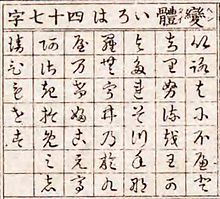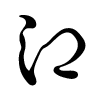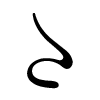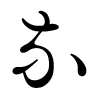Hentaigan
The hentaigana (変体仮名, hentaigana?) are alternative ways to write the kana characters. Historically, they are the manyogana, which allow the same syllable to be represented by different kanji characters that were simplified and gave rise to cursive forms that we know as hentaigana. Hentaigana could be used more or less interchangeably with the equivalent hiragana until 1900, when the hiragana syllabary was standardized so that only one character represented a mora.
The "syllabic n" from hiragana (ん) comes from a hentaigana that represented /mu/. The spelling reform of 1900 separated the two usages, specifying that む would only be used for /mu/ and ん for syllable-final /n/. Previously, in the absence of a syllable-final /n/ character, the sound was spelled (even if not pronounced) the same as /mu/, and readers had to resolve the ambiguity by context.
Hentaigana are considered obsolete in modern writing, but are still used in certain cases. For example, many soba shops use hentaigana to write kisoba on their signs. The hentaigana characters are also used in some formal handwritten documents, most notably certificates issued by classical Japanese cultural groups (such as traditional martial arts schools, etiquette groups, religious study groups, etc.). Also, hentaigana are sometimes used in reproductions of classical Japanese texts. It could be said that hentaigana are used in Japanese in a similar way to how medieval Gothic script is used in Latin script languages to give the text an ancient feel. However, the majority of the Japanese population cannot read hentaigana and can only recognize a few characters due to their common use on signs or from context.
Incomplete list of hentaigana characters
Contenido relacionado
Ϙ
Ν
Emilian-Romagna language
















